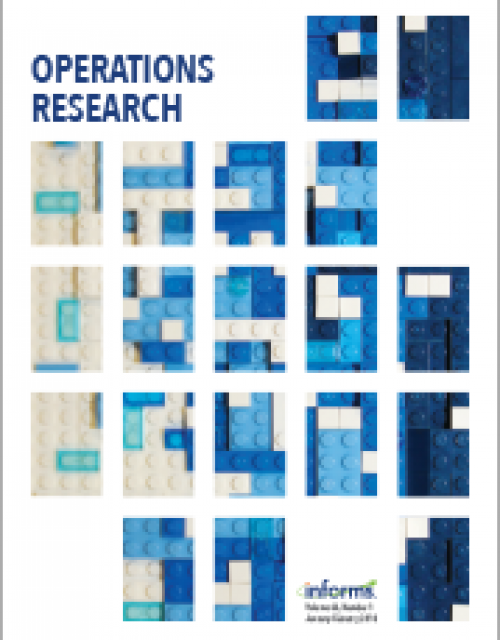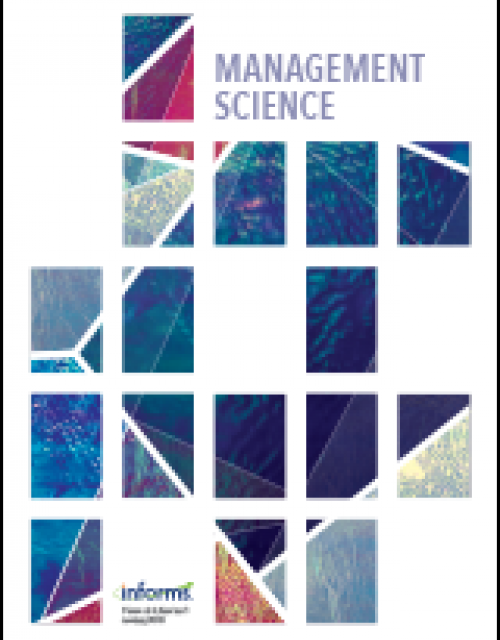Publication records
Subject(s)
Management sciences, decision sciences and quantitative methods
Keyword(s)
Sequential decision making, time pressure, information search, Bayesian inference
Arrow et al. (1949) introduced the first sequential search problem, “where at each stage the options available are to stop and take a definite action or to continue sampling for more information." We study how time pressure in the form of task accumulation may affect this decision problem. To that end, we consider a search problem where the decision maker (DM) faces a stream of random decision tasks to be treated one at a time, and accumulate when not attended to. We formulate the problem of managing this form of pressure as a Partially Observable Markov Decision Process, and characterize the corresponding optimal policy. We find that the DM needs to alleviate this pressure very differently depending on how the search on the current task has unfolded thus far. As the search progresses, the DM is less and less willing to sustain high levels of workloads in the beginning and end of the search, but actually increases the maximum workload she is willing to handle in the middle of the process. The DM manages this workload by first making a priori decisions to release some accumulated tasks, and later by aborting the current search and deciding based on her updated belief. This novel search strategy critically depends on the DM's prior belief about the tasks, and stems, in part, from an effect related to the decision ambivalence. These findings are robust to various extensions of our basic set-up.
© 2019, INFORMS
Volume
70
Journal Pages
1293–1952
Subject(s)
Management sciences, decision sciences and quantitative methods; Technology, R&D management
Keyword(s)
decertification, innovation, quality management, standards
JEL Code(s)
L15, O32, L25.
The literature on quality-management standards has generally focused on the drivers, motivations, and performance effects of adopting such standards. Yet the last decade has witnessed a substantial degree of decertification behavior, as organizations have increasingly decided to voluntarily withdraw from quality-management standards by not recertifying. While the drivers of the decision to initially adopt quality-management standards have been extensively studied, the drivers of the decision to decertify have received scant scholarly attention. We argue that innovative organizations are generally prone to retaining quality-management certification and thus exhibit a tendency to not abandon certification; however, radically-innovative organizations are more prone than incrementally-innovative organizations to discontinue quality-management standards and thereby exhibit a tendency to withdraw from quality certification. We compile World Bank data surveying facilities based in 50 countries and 103 industrial sectors across the 2003 to 2017 period. Taking advantage of the data’s panel properties yields a dataset composed of up to 1,755 facility-level observations of recertification decisions for empirical analysis. Our empirical testing employs a probit estimation technique that accounts for the appropriate fixed effects and generates results that support our theoretical priors regarding decertification behavior.
View all ESMT Working Papers in the ESMT Working Paper Series here. ESMT Working Papers are also available via SSRN, RePEc, EconStor, and the German National Library (DNB).
Pages
54
ISSN (Print)
1866–3494
Subject(s)
Economics, politics and business environment; Management sciences, decision sciences and quantitative methods
Keyword(s)
subjective probability, choice under uncertainty, online experiments
JEL Code(s)
D01, D81, D84, C09
Anscombe & Aumann (1963) offer a definition of subjective probability in terms of comparisons with objective probabilities. That definition - which has provided the basis for much of the succeeding work on subjective probability - presumes that the subjective probability of an event is independent of the prize consequences of that event, a property we term Prize Independence. We design experiments to test Prize Independence and find that a large fraction of our subjects violate it; thus, they do not have subjective probabilities. These findings raise questions about the empirical relevance of much of the literature on subjective probability.
View all ESMT Working Papers in the ESMT Working Paper Series here. ESMT Working Papers are also available via SSRN, RePEc, EconStor, and the German National Library (DNB).
Pages
49
ISSN (Print)
1866–3494
Subject(s)
Management sciences, decision sciences and quantitative methods; Strategy and general management
Keyword(s)
deep learning, nlp, transformers, leadership, semantic networks, distributed representations
JEL Code(s)
C45, D7, D85
This dissertation proposes methods that bridge network science, machine-learning, and agent-based simulations to infer information about context-dependent relationships. The methods are applied to analyze and understand the roles and actions associated with organizational leadership. Findings indicate, among other things, that effective leadership, both as found in practice and in theory, may be more authoritative and hierarchical than is commonly asserted.
Journal Pages
156
Subject(s)
Human resources management/organizational behavior
Keyword(s)
Employer attractiveness, organizational commitment, current employees, existing employees, employer brand
JEL Code(s)
M12
With the growing interest in employer attractiveness, research is unsystematic on how this phenomenon can be conceptualized and studied. Studies tend to make little conceptual differentiation regarding for whom employers should be attractive, and therefore, address the perspectives of potential as well as current employees, who work in organizations for long periods of time. In this study our arguments relate to the phenomenon’s conceptual clarity as well as its differentiation from other related concepts. By focusing on employer attractiveness for current employees, we have systematically reviewed 48 studies published in business and management journals, and categorized findings into the Inputs-Mediators-Outputs model. This approach allowed us to depict significant limitations in the existing knowledge about employer attractiveness from the current employees’ perspective, and offer avenues for future research. Next, to delineate the future research agenda, we have concluded this study with a discussion on what our findings mean for managers and organizations.
Volume
13
Keyword(s)
hedge funds, cash flows, hot hand fallacy, performance streaks, relative weights, smart money
Cash flows to hedge funds are highly sensitive to performance streaks, a streak being defined as subsequent quarters during which a fund performs above or below a benchmark, even after controlling for a wide range of common performance measures. At the same time, streaks have limited predictive power regarding future fund performance. This suggests investors weigh information suboptimally, and their decisions are driven too strongly by a belief in continuation of good performance, consistent with the “hot hand fallacy.” The hedge funds that investors choose to invest in do not perform significantly better than those they divest from. These findings are consistent with overreaction to certain types of information and do not support the notion that sophisticated investors have superior information or superior information processing abilities.
© 2021, INFORMS
Volume
68
Journal Pages
4151–4172
Subject(s)
Strategy and general management
Keyword(s)
General managers, middle management, digital strategy, call centers
The case tells the evolution of the call center transformation at Frontelco (a major telecom company in disguise). “Digital” and “agile” approaches to changing the way how call centers operate seem to produce different results. Debate between proponents of alternative approaches takes place across three levels of organizational hierarchy: the Managing Director seems to prefer “agile”, those close to operations in VP ranks seem to prefer “digital”, while three “managers in the middle” following each other in Senior Vice President rank seem to follow different strategies as to how to align the top and the bottom. To settle the debate, evidence-based clarity is being sought and the protagonist is tasked to design an appropriate performance measure to show the real impact of competing approaches.
| buy now | buy now | buy now |
Subject(s)
Technology, R&D management
Keyword(s)
patents, drugs, data exclusivity, clinical trials
JEL Code(s)
K41, L24, L65, O31, O32, O34
Volume
104
Journal Pages
574–586
Subject(s)
Human resources management/organizational behavior
Keyword(s)
methods, measures, research transparency, open science,reproducibility, meta-science, negotiation,conflict, cooperation, competition
Conflict management scholars study mixed-motive negotiation situations with cooperative and competitive incentives predominantly through multi-issue negotiation tasks in experimental studies. Intriguingly, experimenters currently lack an objective, generalizable, and continuous measure that precisely quantifies the incentives underlying these negotiation tasks. We present the conflict strength coefficient, which enables scholars to systematically quantify the incentive structures in these multi-issue negotiation tasks. By making the incentive structures accessible and numerically comparable, the conflict strength coefficient provides new insights into the central element of the experimental study of negotiation and conflict management, unmasks differences across existing tasks, facilitates research transparency, knowledge sharing, and open science practices. We demonstrate the coefficient’s benefits by providing a hands-on example from past research, by reviewing and quantitatively assessing the current literature, and by mapping conflict strength coefficients for the negotiation and conflict management research landscape and its subareas. Our analysis suggests that the conflict strength coefficient can enrich the understanding of cooperative and competitive incentives in the established tasks and directly guide and support an individual scholar’s process of knowledge creation. The conflict strength coefficient provides a methodological contribution to the experimental study of conflict management and negotiation with immediate benefits for the production of scientific knowledge, the experimental study of real-world phenomena, and theory development.
Volume
8
Subject(s)
Human resources management/organizational behavior
Keyword(s)
Leadership development, executive education, business impact
JEL Code(s)
M53
Executive Education must be seen as an investment. If we are serious about achieving business impact through training, the first question should be “What business outcomes would we like to see because of this intervention?” Next, we ask questions like “How, where, and when do we need our leaders to perform better to achieve those business outcomes” and “What specific knowledge and skills do we need to equip our leaders with to deliver the improved performance?”. We illustrate this approach through our work with one of the world’s largest commercial vehicle manufacturers, TRATON.
Journal Pages
18–25

